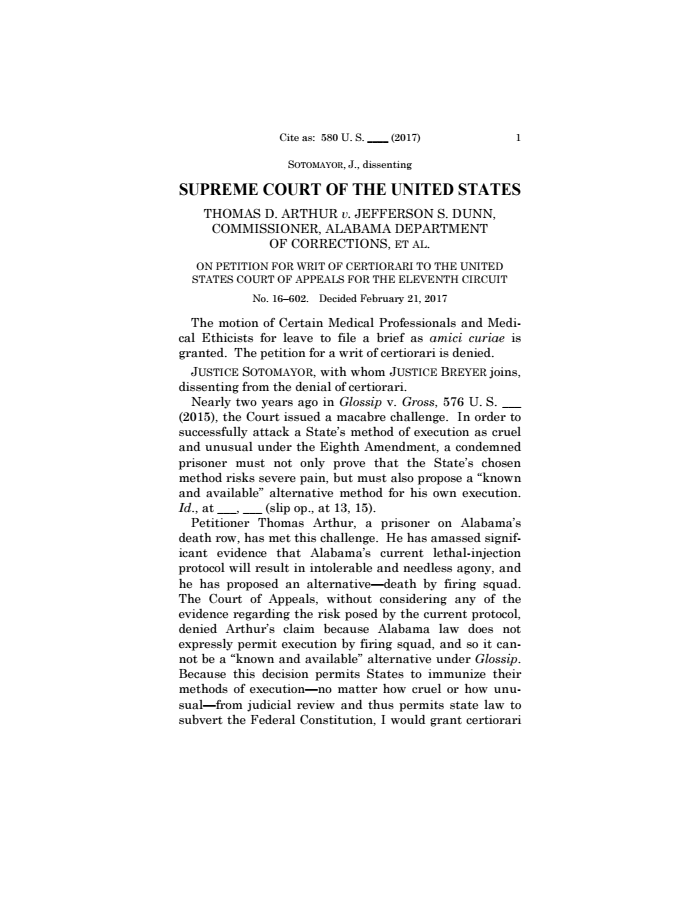
The US Supreme Court declined on Tuesday to hear a case brought by an Alabama death row inmate challenging the conditions under which he will be executed — a move that two justices say allows states to avoid similar challenges "no matter how cruel or how unusual" their method of execution might be.
The high court had halted Tommy Arthur's execution in November, with Chief Justice John Roberts issuing a so-called courtesy fifth vote. It only takes four justices to decide to hear a case, but requires five justices to issue a stay of execution.
In order to challenge a method of execution, however, death row inmates have to prove the method risks severe pain — but also propose a “known and available” alternative way to be executed.
The lower court held that Arthur's alternative method — the firing squad — cannot be a "known and available" alternative because it is not "expressly permitted" under Alabama law. On Tuesday, the Supreme Court declined to review that decision.
In an 18-page dissent from the court's decision not to hear the case, Justice Sonia Sotomayor wrote Arthur had met his “macabre challenge.”
Alabama uses a three-drug execution protocol: A controversial sedative used in several botched executions, followed by a paralytic, and then a drug that stops the heart. The final drug feels like fire coursing through your veins, and both states and inmates agree that, if an inmate were not properly sedated, the final drug would be incredibly painful.
"Execution absent an adequate sedative thus produces a nightmarish death," Sotomayor wrote, joined by Justice Stephen Breyer. "The condemned prisoner is conscious but entirely paralyzed, unable to move or scream his agony, as he suffers 'what may well be the chemical equivalent of being burned at the stake.'"
Arthur alleged that midazolam was not suitable as a sedative, as it has a "ceiling effect," which, when reached, means more of the drug won't increase sedation. It was here that Arthur instead asked that he be executed by firing squad and lower courts dismissed his claim because the firing squad is not currently allowed as a method of execution under Alabama law.
"Under this view, even if a prisoner can prove that the State plans to kill him in an intolerably cruel manner, and even if he can prove that there is a feasible alternative, all a State has to do to execute him through an unconstitutional method is to pass a statute declining to authorize any alternative method," Sotomayor wrote. "This cannot be right."
The sedative midazolam has been used in several high-profile botched executions. Sotomayor pointed to problematic executions using the drug in Ohio, Oklahoma, Arizona, and even Alabama.
"Science and experience are now revealing that, at least with respect to midazolam-centered protocols, prisoners executed by lethal injection are suffering horrifying deaths beneath a medically sterile aura of peace," she wrote.
"Twice in recent years, this Court has observed that it 'has never invalidated a State’s chosen procedure for carrying out a sentence of death as the infliction of cruel and unusual punishment,'" Sotomayor wrote. "We should not be proud of this history."
Arthur was sentenced to death for a 1982 murder-for-hire scheme. In delaying his November execution, Roberts wrote that he did not think the court should grant the stay because the case “does not merit the Court’s review."
Roberts stated that he was voting to stay the execution because "[f]our Justices have, however, voted to grant a stay. To afford them the opportunity to more fully consider the suitability of this case for review, including these circumstances, I vote to grant the stay as a courtesy.”
A month later, Roberts did not vote for a stay in a different case and Alabama was allowed to carry out an execution using its three-drug protocol. The execution lasted more than 30 minutes, where the inmate “clenched his fists and raised his head during the early part of the procedure" and “heaved and coughed through about 13 minutes.”

